Evolution of Snowmobile Front Suspensions
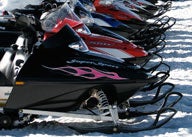
Leaf spring suspensions held on for decades
Vintage riders know just how far snowmobiling has come with front suspension comfort and how it affects handling and safety. Snowmobiles from the leaf spring era, which was pretty much from the beginning right up to the 2011 Yamaha Bravo, relied on a variety of front suspension technologies that really didn’t change much over the decades. When Polaris first adopted the trailing arm independent front suspension (IFS) for what would become the most popular line of sleds in snowmobile history, the leaf spring remained relevant in every snowmobile line of the period. Where the leaf spring design had become a staple, alternative suspension concepts were unsettled.
The whole idea of the leaf spring evolved. Though it would be the ubiquitous concept for decades, leaf springs battled simple coil spring designs such as those found on the first rear-engined Polaris Sno-Travelers from the mid-1950s. By 1960 Ski-Doo settled on the leaf spring, but it too had played with a simple coiled spring surrounding an early model’s ski spindle. If you have a modern “clicker” pen, take it apart and note the spring and how it reacts when you “click” or press the plunger. That’s the same concept as some early snowmobile front-end suspensions. This was all a basic step beyond no suspension at all.
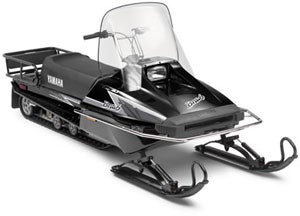 Continued into 2011 Yamaha’s Bravo 250 came standard with a leaf spring suspension.
Continued into 2011 Yamaha’s Bravo 250 came standard with a leaf spring suspension.The last of the leaf spring Yamaha Bravo models claimed upwards of four inches of vertical travel. Compare that to the nine inches of dampened front travel on a Venture GT. The leaf spring’s travel measured from the bottom of the center-mounted stopper to the top of the ski and reflected a full collapse, which would mean a substantial kick back up the handlebar upon rebound. Yes, leaf sprung sleds did utilize shock absorbers, but they had limited effect as they mostly kept the ski’s nose down to help keep the ski under control in the wild wobblies. Modern front ends such as Yamaha’s double wishbone design give the operator upwards of nine inches of travel that is controlled via various shock absorber components and springs. Geometries can be adapted by simply redesigning arm lengths, adjusting caster angles and the like. Today’s new front suspensions provide extreme versatility when compared to the leaf springs of the old days.
The benefits of leaf spring suspensions and why the design lasted into the 21st century turned on simplicity, component costs and the ability for them to be repaired virtually anywhere with a bare minimum of know-how. Of course, leaf springs came in varied forms from incredibly simple single leaf design to tapered multi-leaf designs to transverse setups; like the one used on the 1988 Yamaha SnoScoot and the 1970s Sno Pony models.
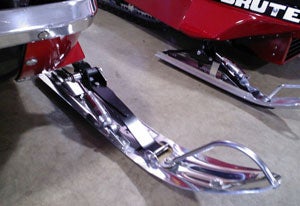 Racing and performance sleds of the 1970s and 1980s frequently added shock absorbers to assist the basic leaf spring ski suspension and keep the skis from flying wildly up and down.
Racing and performance sleds of the 1970s and 1980s frequently added shock absorbers to assist the basic leaf spring ski suspension and keep the skis from flying wildly up and down.Breaking away from leaf springs took time. Snowmobile manufacturers didn’t want to add unnecessary costs to their sleds, which would have to be passed along to the buyers. Keep in mind that as a result of their success and rapid growth, the snowmobile companies by early 1970 were expected to sell upwards of one million units per year! Of course, sled sales never reached that level, peaking at just under 500,000 sleds sold and trending downward from the 1970s to a fairly consistent 250,000 units in the early 21st century and then falling back to less than 150,000 currently. Just as now, mitigating factors caused the fluctuations. In the 1970s there was an oil crisis. Sound familiar? The economy soured. Sound familiar? But, maybe as important to all that was the federal government.
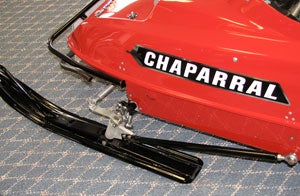 This 1972 Chaparral Firebird SSX oval racer featured a trailing arm independent front end as an alternative to leaf springs.
This 1972 Chaparral Firebird SSX oval racer featured a trailing arm independent front end as an alternative to leaf springs.Since snowmobiles weren’t regulated in that time and miles of groomed trail networks didn’t exist, local, state and federal governments sought to put restrictions on sleds. One such constraint that cost consumers dearly was noise restrictions. Sleds were deemed too loud. The sled makers poured untold resources into reducing the sound output of their products. Hoods were sealed off. That led to higher underhood temperatures, which eventually led to liquid-cooled engines. Of course, all of these changes didn’t happen overnight, but the priority on sound reduction did thwart spending on new front-end designs, especially where the use of leaf springs was readily accepted as the standard. Why change and pass along added costs?
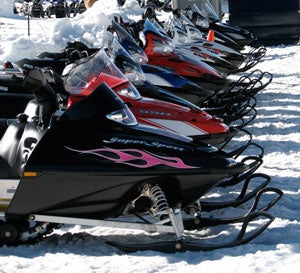 Polaris’ Super Sport utilized the IFS trailing arm front end alongside the newer A-arm IQ design.
Polaris’ Super Sport utilized the IFS trailing arm front end alongside the newer A-arm IQ design.The bulk of consumer sleds remained with leaf springs, but in order to gain the upper hand in racing, sled manufacturers realized that leaf springs had limits. While the snowmobile manufacturers like to lay claim to all new great concepts, the fact is that more often than not the aftermarket entrepreneurs experiment first, create a demand and then manufacturers follow. In the case of IFS, a racer, Gordon Rudolph, predated the official Polaris designs. Even famous Indy car driver Bobby Unser claims to have developed the concept for snowmobiles with a setup for oval racing sleds. The fact remains that the first full production sled was the 1980 Polaris TX-L Indy. Trailing arms were “in.” Polaris soared to Number One in industry sales.
Leaf springs didn’t disappear, not even from the Polaris line, but they were viewed as “old” technology as new sled buyer wanted the latest racing-inspired designs. While Polaris scored with IFS, the other sled makers tried other ideas. Yamaha engineers borrowed some tried and true motorcycle concepts simply known as telescopic struts. Pretty much springs dampened by shocks in a tube, the Telescopic Strut Suspension was re-imagined as the “new” idea. In a straight line over bumps, Yamaha’s TSS worked great. By the time the last TSS-equipped Yamaha snowmobile left the snows, the company’s engineers had gotten the design to corner and handle as well — if not better — as contemporary IFS designs, which Yamaha went to after it gave up on TSS.
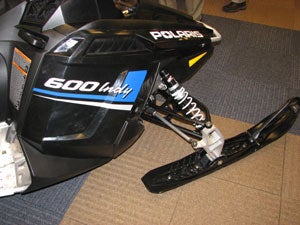 The original Indy 600 featured a trailing arm and not the A-arm front of the new-for-2013 Indy models.
The original Indy 600 featured a trailing arm and not the A-arm front of the new-for-2013 Indy models.Ski-Doo being Ski-Doo, couldn’t abide utilizing a proven IFS concept and went its own way — many times! The best non-IFS design was called PRS, which actually brought the majority of suspension unsprung weight inboard and used a bell crank system working with shocks to control travel. This progressive rate design worked pretty well, but consumers perceived the Polaris IFS as the best design due to its winning ways at the races – ovals and cross country terrain.
In this time, Ski-Doo unleashed its own version of a telescopic strut design on the Stratos. Then there was a modified trailing arm design in the Safari series that followed. Now the REV models utilize a double A-arm design, which became popular when Arctic Cat unveiled its own Arctic Wishbone Suspension (AWS). Of course, Polaris pooh-poohed the concept as inferior to its trailing arm design.
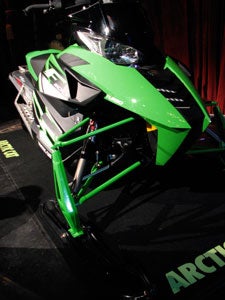 Tall spindles give the 2013 Arctic Cat ARS its unique style.
Tall spindles give the 2013 Arctic Cat ARS its unique style.Ah, yes, in one of the most disingenuous marketing campaigns in recent memory, Polaris bad-mouthed all A-arm suspensions as being inadequate. Right up to the introduction of the all-new Polaris Fusion, which dropped the tried and true Polaris IFS in favor of, you got it, a new Polaris IQ A-arm suspension with 10-inches of travel! My, oh my! Of course, Polaris claimed its design trumped all others. Maybe it did as the basic concept lives on in many updated iterations.
As mentioned, Arctic Cat moved adroitly from leaf springs to A-arm designs. The biggest evolution can be seen in the current models with the incredibly tall spindles that give Cats their instantly identifiable birthmark. Born, tested and proven on the snocross and terrain courses of the racing world, the current Arctic Racing Suspension affords this current litter of Cats exceptional grip and prowess on the trail.
Interestingly, snowmobile front-end designs evolved from simple leaf springs to being settled in on various A-arm designs. The leaf spring survived through the decades due to its simplicity, effectiveness and relatively low cost structure. Over that time, we have seen three major suspension designs used to replace it — telescopic struts, trailing arms and today’s A-arms. While Yamaha became known for its use of telescopic struts, John Deere most likely would have added that front suspension to its line of trail sleds had the company not pulled the plug on its sled group. Ski-Doo did use a form of the strut suspension and it remains part of the culture for Ski-Doo’s most serious Tundra off trail utility sleds sold in the Arctic Circle.
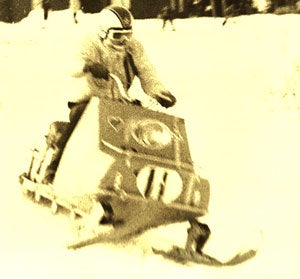 This “period” shot of an Ockelbo Racing in Arjeplog, Sweden, shows off its knuckle-joint ski suspension that was used instead of leaf springs.
This “period” shot of an Ockelbo Racing in Arjeplog, Sweden, shows off its knuckle-joint ski suspension that was used instead of leaf springs.And, yes, there was another alternative to the leaf spring from an early period. The now defunct Ockelbo snowmobiles utilized a rubber knuckle to provide a ski suspension, but it never caught on outside of Scandinavia. Leaf springs may never disappear as they still survive in snowmobiling as the suspension components on tow-behinds and, of course, on many of the trailers we use to get our modern designs to the snows.
Related Reading What Will Power Snowmobiling’s Future? What is Snowmobiling’s Next Big Thing? 7 Things Modern Sledders Won’t Need to Worry About



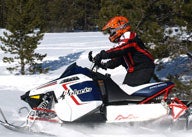
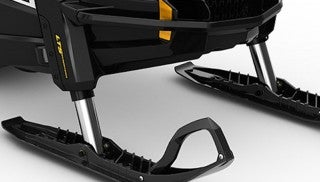
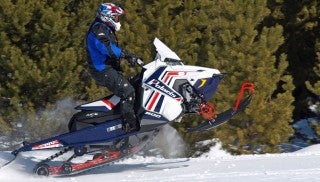


 Your Privacy Choices
Your Privacy Choices